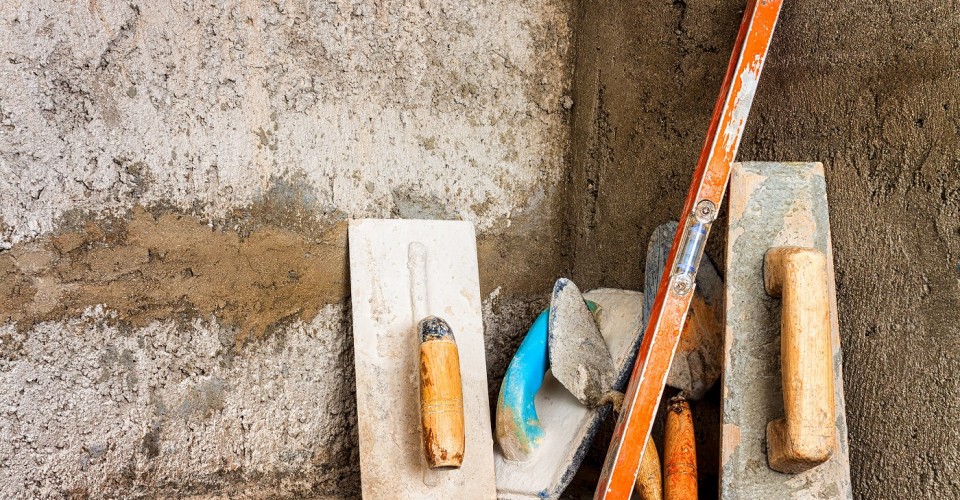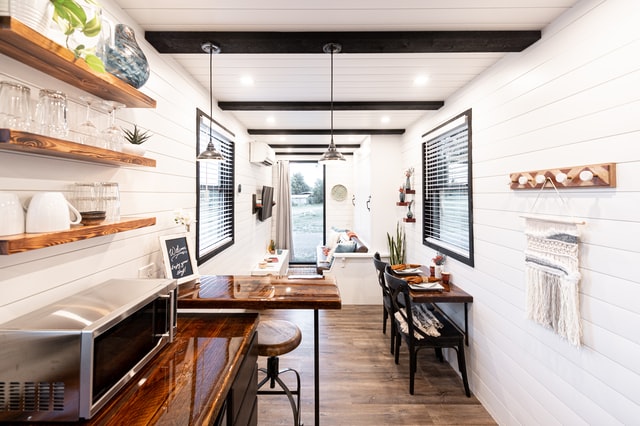Before the 1950’s, plaster and lath was the typical way to create walls and ceilings. Plaster is a very ancient way of creating a smooth wall and has been used in decorative molding, ceilings and walls for centuries. Plastering freehand and creating a smooth surface on ceilings and walls is a very difficult skill and quite laborious. The housing boom of post-World War II created a need for a faster and cheaper way to create smooth walls, that didn’t require technical skills. The answer to this came in the form of drywall (also known as gypsum board or sheetrock), which was cheaper to purchase and easier to install. Some plaster and lath walls are durable and fully usable after decades and many older U.S. homes still have plaster and lath construction. But depending on the quality of installation and the level of maintenance and upkeep, the condition may be worn down or damaged. Having a home inspector check for insulation levels within the walls and making regular repairs, can help ensure you maintain a healthy and safe environment for you and your family.
What is plaster and lath?
In new home construction, we typically see interior walls constructed of wooden studs to which large sheets of drywall are attached. Once nailed to the wood studs, a professional sheetrock installer will cover the seams with drywall tape, then a coat of plaster. Before sheetrock came into existence in the 1950’s, interior walls and ceilings were constructed slightly differently. Narrow strips of wood, called lath, were nailed horizontally across the vertical studs. Lath can be defined as thin, flat pieces of wood that form a foundation for supporting plaster. It is a type of backing material used as a base or for groundwork. These laths were placed close together (about 3/8 inch apart). Once complete, several coats of plaster were layered on top to solidify the framework. The plaster that oozed between the laths is called “keys” and actually plays an important role in the plaster and lath’s ability to absorb sound. Plaster can be defined as a mixture of lime and sand or cement and water that is applied over walls and ceilings on top of lath, to form a smooth hard surface that can be painted over once dry. Depending on the type of plaster, strength and durability may range once the coat is applied. The following are different types of plaster and lath that are used:
Plaster
Gypsum: Formed and settled by heating up a dried plaster powder with water. Durable, sound and fire-proof.
Lime: Created by mixing water and sand the material provides a natural, mold resistant and breathable finish.
Cement: Cement-based plasters are strong and usually used for exterior structures, but can be lasting and endure harsh weather.
Lath
Rock: Similar to drywall, rock lath consists of a gypsum core between paper coverings that bond together to secure in place. It’s moisture resistant and can be simply attached, but can also easily develop long cracks.
Wood: The most common wooden-slat laths are still used in construction and come in narrow strips with spaces between each. The plaster is pushed through the spaces and fills the inside of the wall forming keys that hold the plaster in place.
Metal: Made up of steel and able to hold and withstand a greater amount of plaster than wood lath, resulting in durability.
Should I keep plaster and lath walls or replace them?
There are actually many advantages to a plaster and lath construction. Most importantly is it’s ability to absorb noise and deter the spread of fire. The keys, with their irregular shapes between the walls, act as acoustical and sound absorbing elements and the lime plaster is denser than new gypsum board. Even dense brownstones in older neighborhoods can hear the difference between rooms fitted with plaster and lath compared with contemporary drywall. The traditional lime plaster material is also known for inherent fire resistance. Studies have been limited however, it is known that carbonated lime (lime that has had months to cure) will spread fire slower than traditional drywall. Additionally, there is less space or air between the wall or ceiling layers, potentially giving fire less oxygen to work with. You can read more about this study at Building Conservation. Plaster and lath construction also allows for a greater curvature of a wall or ceiling compared with standard sheetrock.
Although plaster and lath were used as a reliable form of wall finishing, there are some issues that have presented themselves over time. Your home’s walls age and wear down, which may cause your walls to break away or crack. The problem with plaster is that unlike drywall that attaches directly to studs inside walls, plaster is coated over the top of lath and the wood lath is attached to the wood studs. This can cause the plaster to easily become loose and crack along the walls. When plaster is applied to a wall, the mixture of plaster is hand-pushed through the spaces inside the wall to form the keys, which holds the plaster in place. In the result of poor workmanship, improper application, or excess moisture entering the plaster and lath walls, the material is more likely to crack or separate from the framework.
Signs you may need a repair
If a house has not been inspected or updated regularly, take time to inspect the condition of the walls. Have your home inspector check for necessary repairs, such as crumbling or bumpy plaster along walls, cracked ceilings, and insulation levels within the walls. Some homeowners, interested in purchasing a historic home, may even choose to bring along a skilled contractor to receive an on-site estimate for wall repairs. This might also be a good idea if you are thinking that you’ll want to upgrade or insert additional insulation between the walls. Recognizing necessary repairs and knowing warning signs that the structural elements or foundation of your home are not up to par can help you stay on top of maintaining a quality home condition. The following are a few signs that you may need to repair or replace your home’s existing plaster and lath walls:
Unevenness
When checking your home for worn down surfaces, get in a position where your ceiling surface is easily visible at eye level and look for bumps or ridges to the ceiling texture. You’re looking for surface uniformity across your ceiling. Some unevenness may not warrant an entire repair and may just require some smoothing over. These quick fixes can be done by a DIY method, but in the case that you are experiencing multiple plaster problems, consider consulting a professional’s expert eye to make sure your problem isn’t bigger than you expected.
Sagging
If you find that your ceiling is beginning to sag in distinct areas, this may be a sign that your plaster is detaching from the lath. In some cases your ceiling may naturally slope with age as ceilings tend to settle and recess over time, but if you believe that your plaster may be outdated you may want to call a plastering professional. You can check your ceiling by gently pushing up, underneath the sagging part of the ceiling and if you can feel the movement of plaster up and down, this is a sign that it may no longer be attached to the laths. Before you decide to do a DIY check, know that there is the possibility that debris can fall through or even your ceiling can collapse, so proceed carefully or leave this process up to your professional to ensure safety.
Cracks
Unsupported plaster, once it becomes separated from lath, can result in cracking along walls or ceilings. There is also the chance of leaks occurring within your plumbing systems that may cause water to damage the plaster and also lead to cracks. Some smaller cracks can be temporarily fixed, but may reoccur if not properly taken care of. Signs of cracks can be seen from the naked eye and at first notice should be repaired to ensure the crack doesn’t grow and become more problematic. When looking for cracks in your plaster, check your ceiling and above door framing where a lot of movement or stress on your structure occurs.
Repairing lath and plaster walls
Once you’ve recognized that your walls are in need of a repair or replacement due to worn down plaster and lath, it is beneficial to hire a professional to complete the job for you. A contractor will have knowledge regarding proper construction and building, as well as have access to all the necessary tools and equipment for repairing. Some repairs are smaller and may result in simple fixes, but if you are unsure of techniques proceed cautiously doing it on your own. A common repair for lath and plaster walls is filling in cracks. This can easily be done with the use of patching material as long as the condition of the plaster underneath is still in good condition. Using a utility knife, cut away loose plaster surrounding the crack to make the opening wider, and dust off the extra pieces. Then dampen the outside of the crack and apply a small amount of patching material of plaster over top of the crack and let dry. Finish the fill by sanding over the patch and re-plaster the same area at least another time to ensure the surface is secure and smoothed over. Finish by priming and painting over the filled surface.
Repairing or removing your lath and plaster can be time consuming and costly. Keeping your home maintenance up to date and regularly checking for any signs of cracks or leaks will help make sure you don’t run into a major problem. Depending on the size of your repair, whether your old existing lath or plaster needs to be removed, and your hired service for completing the renovations, the cost of repairing your home’s walls or ceilings may be extensive. The removal of lath and plaster can average from $1 – $5 per square foot and then additional costs will be added for the building of new lath and plaster. You may want to save any removed lath pieces for future repair. These narrow strips of wood may come in handy if you ever need to repair minor sections of the wall or they can be reused for other projects. Stay on top of your home maintenance and set a budget for any of your home repairs so that you don’t find yourself buried in unexpected remodels and excess costs.
Do you have a plastering project you’d like some help with?




